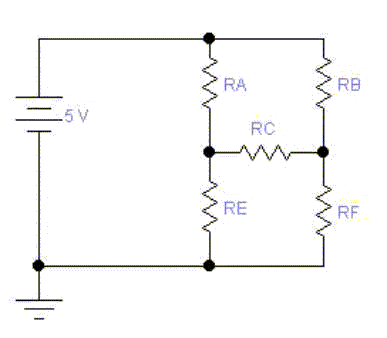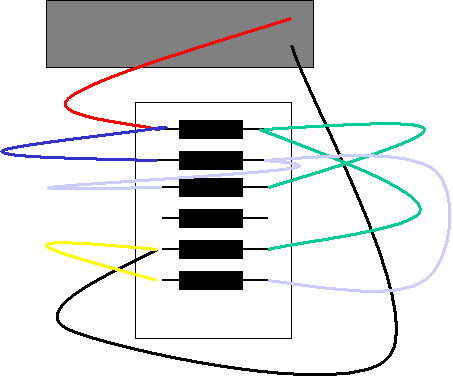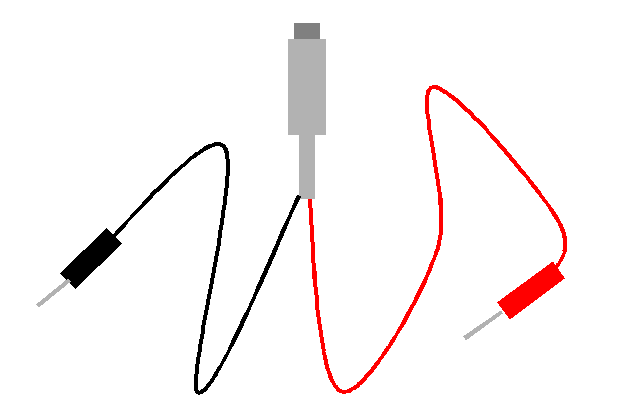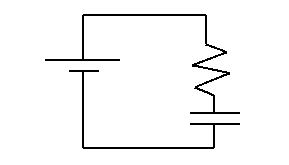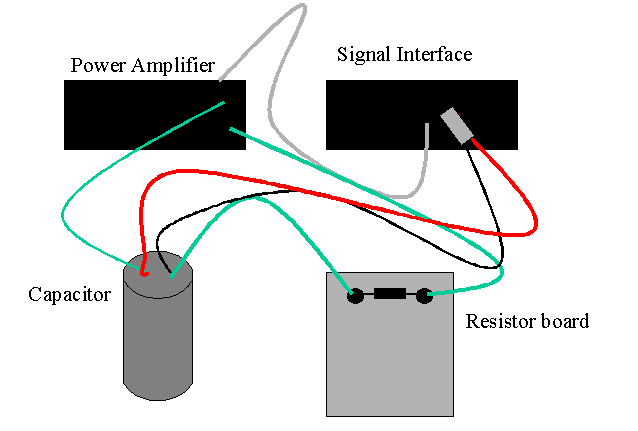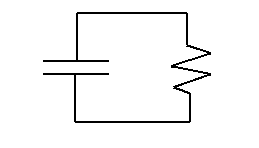

 PYL 106: Kirchhoff and RC Circuits
PYL 106: Kirchhoff and RC Circuits



This lab has two parts. The first part is on Kirchhoff's laws. The
second part is on RC circuits.
Kirchhoff's Rules
If two resistors are in series, then the two resistors can be added to find
the equivalent resistance. If two resitors are in parallel, then the
two resistors can be added reciprocally to find the equivalent resistance.
However, there are arrangements of resistors which are neither in series nor
in parallel. In such cases one can apply Kirchhoff's rules. One rule concerns
nodes – places where wires meet. It says the currents coming into
the nodes must equal the currents leaving the nodes. If this were not true, a
charge (it might be positive or it might be negative) would accumulate at the
node. But nodes are made from conducting materials, and charges do not accumulate
inside conductors (outside perhaps, but not inside). Another rule concerns
loops. It says that as one traces through a closed loop that the gains in
the voltage level must equal the losses in the voltage level. An gravitation
analogy in which the level is height would be that one can walk around a building changing one's height
using stairs, ramps, elevators, but if one comes full circle back to one's starting
point, then any increases in height are balanced by decreases in height.
Charging and discharging a capacitor: RC circuits
When you connect an uncharged capacitor and a resistor
in series to a battery, the voltage drop is initially all
across the resistor. The voltage drop across a capacitor
is proportional to its charge, and it is uncharged at the
beginning. But charge starts to build up on the capacitor,
so some voltage is dropped across the capacitor now. With less
voltage being dropped across the resistor, the current drops
off. With less current, the rate at which charge goes onto
the capacitor decreases. The charge continues to build up, but
the rate of the build up continues to decrease. In mathematical
language, the charge as a function of time Q(t) increases but
its slope decreases.
Theory says the charge obeys
Q(t) = C VS (1 - e-t/τ)
where t is the time, C is the capacitance, VS is the saturation voltage which in this case is equal to
the voltage across the battery, and τ=RC, a
time constant.
The corresponding voltage across the capacitor is
V(t) = VS (1 - e-t/τ)
Now consider the case of a charged capacitor, a resistor and no
battery. With no battery to "push" the charges around, the
opposite charges on the capacitor plates would prefer to be
together. They must pass through the resistor before they can
reunite. With all those like charges on one plate, there is a
strong incentive for charges to leave the plate. However, as
charges leave the plate, this incentive decreases, thus the rate
at which charges leave decreases as well. In mathematical
language, this time the charge as a function of time Q(t)
decreases and its slope decreases.
Theory says the charge obeys
Q(t) = Q0
e-t/τ
where t is the time, Q0 is whatever charge we
happen to start with, and τ=RC
is the same time constant as above. The corresponding
voltage across the capacitor is
V(t) = V0
e-t/τ
where V0 is the initial voltage.
EXPERIMENT 1
- Set up the Simpson multimeter as an ohmmeter. (If there are three holes on the left-hand
side of your multimeter, make sure the red lead is plugged into the hole marked
V-Ω and that the DC (direct current) and
kΩ button are depressed.
- Press the 20 on the lower front.
- Insert one needle in each hole adjacent to the resistor, allow
some time for the reading to settle down, and record the
resistance below.
- Measure the resistances RA, RB, RC, RE,
RF and record them in the table below. (Resistances are measured when the resistor
is not connected to a circuit.)
- Next, connect the resitors in a circuit like that shown below
Your version may look more like this
Look in the above circuit for resistors that are in series (resistors are
in series if the current passing through the first is the same, no more
no less, as that passing through the second). There are none!
Look in the above circuit for resistors that are in parallel (resistors are
in parallel if the "tops" and "bottoms" of the resistors are connected
by wire and only wire). There are none. The analysis of such circuits
requires Kirchhoff's rules.
- Set up the power amplifier as a DC power supply, connect it to Data Studio, etc.
Set it to a volatge difference of 5 volts.
- Set up the Simpson multimeter as a voltmeter and measure the voltage across the
resistors and enter them in the table below.
Data from Kirchhoff Experiment
| | Resistance
( )
| Voltage
( ) |
Current From Experiment (use Ohm's Law)
( ) |
Current From Theory (use Kirchhoff's rules)
( ) |
Percent
Error |
| RA | | |
| | |
| RB | | |
| | |
| RC | | |
| | |
| RE | | |
| | |
| RF | | |
| | |
- Obtain the experimental current from your resistances and voltages using Ohm's law I=V/R and enter
them into the table above.
- Solve Kirchhoff's laws for the currents in your circuit and enter them into the table above.
Include the solution in your report. (Collect the data for the second part of the experiment before
performing this analysis.) One way to solve Kirchhoff's equations is by using a matrix approach,
for an explanation of this approach, see
this slide show on Kirchhoff.
Here is a matrix equation spreadsheet like the one
discussed in the slide show.
EXPERIMENT 2
Part I: Charging:
Discharging:
- With the voltage sensor across the now charged capacitor,
begin recording a new set of data.
- Connect the capacitor to resistor RA (no
power supply).
- The voltage should start close to 5.00 V and decay to zero.
Diagrammatically the circuit looks like the following
- Copy and paste the data (times and voltages) into Excel.
- For this case
you can use the exponential option in Add trendline. Compare
the τ's.
Part II
- Repeat the charging part of the above measurements with
resistor RB.
- Then repeat the discharging part of the above
measurements with the combination of RA
and RB in series.
- Do the plotting as above and compare
τ's.
- Does the result agree with theory?
Discharging R
A and R
B
| V0 ( ) | |
| τ ( ) | |
| Theory τ( ) | |
| Percent Error | |
Part III
- Get the measurements of the resistances RA and RB
from the Kirchhoff part of the lab.
- Use your results to extract the capacitance. Note this
is the first time we have a capacitance as opposed to a ratio
of capacitances.
Include in your report:
- What is your best estimate of the time constant if the
resistors in the part-II discharging had been in parallel?
- What would happen to the time constant (increase or decrease)
if we replaced the single capacitor with the combination of it and
a second capacitor in series? Why?
- What would happen to the time constant (increase or decrease)
if we replaced the single capacitor with the combination of it and
a second capacitor in parallel? Why?


 PYL 106: Kirchhoff and RC Circuits
PYL 106: Kirchhoff and RC Circuits




